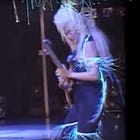Like many things in our culture, rock was initially reserved for boys. Most early female rockers were considered curiosities, forced to tart themselves up to get any play. Others met violence (Chrissie Hynde was gang-raped, Jacky Fox was assaulted by her own manager, Tina Turner endured years of domestic abuse even while touring with her husband).
In many cases, women rockers were condescendingly tolerated because they were “cute”. Some of the early pioneers left performing because of the abuse and sexism (Fox, June Millington and Cherie Currie are good examples). Being a female rocker was not for the faint-hearted.
A few of the pioneers refused to play the T&A game, and in the end, they are the ones who made a lasting impact. Joan Jett, Suzi Quatro, Hynde, Pat Benatar and the Wilson sisters are great examples. Some of them performed in jeans, others in biker clothes. Their stage shows didn’t include armies of backup dancers twerking and pole-humping. They were living proof that women don’t have to prostitute themselves or wiggle their private parts at the camera to succeed in popular music.
The late 1970s and early 1980s saw several honest-to-goodness female rockers break through. Fanny, the Pleasure Seekers, the Runaways, Quatro, Jett, Heart, Hynde, Benatar, Patti Smith, and Siouxie and the Banshees achieved varying measures of success. A few woman-fronted, mixed-gender hard-rock bands like the Pretenders, Blondie and the B-52s became major icons of the era and still get widespread airplay today.
Commercially, the most successful “girl bands” were the Go-Gos and the Bangles. Their success, however, also illustrated some of the limits on what was acceptable for women. They certainly knew how to play, but their management ensured they kept things mainstream, doing mostly pop-rock. They were careful to keep their appearance non-threatening.
Still, whether your thing was pop rock or something with more of a snarl, it seemed to be a golden moment for women in rock.
Then that moment ended. Where women in rock are concerned, the American music industry regressed sharply, and has not recovered. (Rock overall has itself shrunk to a niche market, a factor that has to be taken into account. I have touched on that in other columns.) Now, for women and even to some extent for men, it’s all about pornified display and formulaic pop.
The good news for women is they have found themselves at the top of the heap in pop music (Swift, Bey, Adele, Rihanna etc.) The bad news is that, in the U.S. at least, they are almost entirely confined to the singer-songwriter lane. Few of them take on more technical roles like actually playing instruments, or mixing, mastering and other aspects of production. I’ve also written about this, and it is a topic that could easily consume a dozen more columns.
It's not that female rockers entirely quit. The were forced underground but kept banging away. Punk groups like Bikini Kill and 7-Year Bitch, in which women played all the instruments, are regarded today as artistically important, but never broke through commercially, in part because of violent opposition from male gatekeepers of the punk scene.
Seven Year Bitch “Hip Like Junk”
As a spin-off of hard rock, metal was initially even more sexist and macho. Like punk, which emerged in parallel, metal culture actively excluded women, pushing those women who wanted to play into their own underground scene. There have been breakthrough guitar (or bass) heroes like Jenn Batten:
Gail Ann Dorsey:
Sara Lee:
and Gretchen Menn:
but they have generally played supporting roles to male mega-stars like Michael Jackson and David Bowie.
Nevertheless, a few groups made a go of it. One of the earliest female-led metal bands was Femme Fatale (founded 1987), a mixed gender band that ended up having two moderately successful hits. They originated during the heyday of arena rock and the male hair-metal bands, so, almost by default, they adopted similar styles of songwriting and visual presentation. The group disbanded and reformed multiple times.
“Waiting for the Big One”
Vixen were founded in 1980, but went through a lot of personnel changes before their most successful lineup solidified in 1987. They ended up being the only American all-female metal group from the early era that left a legacy. Like Femme Fatale, they look and sound a lot like the male hair-metal bands of that era.
Vixen could certainly play, but they faced constant pressure from their label to write more poppy songs and to tart up their look, and that’s what got released. Here is something that was not commercially released, but survived as a demo. I happen to think it’s better than any of their published work (to view this, click the “watch on youtube” link in the box below):
Vixen went through several lineup changes, and prolonged periods without label support. Their founder and original lead guitarist died of cancer in 2013. They never gave up--they kept coming back and are still playing major rock festivals. But they were almost alone in the American metal scene.
In the next installment in this series, I’m going to take a tour of the metal scene from the late 80’s to the present day, with a focus on the role women played. Vixen and their peers may have dented the metal ceiling; the next generation of “metal chicks” would hammer away and eventually break it.







This is such an important and big topic, and I'm glad you are documenting it. For me, it really gets to the heart of how the music industry operated (and operates now) and as time went on became increasingly corporate, driven by profit targets and averse to any risk, and run by non-musicians. (As we've seen in many industries, and why so many of them are falling apart as customers look for other avenues and abandon them.)
It's also not surprising given how few women were allowed to take on other roles in that world. Where were the women producers, managers, arrangers, journalists, critics, etc etc? I'm always surprised when I run across a woman who actually had a significant role in that system. Even now, how many women feel comfortable writing about rock on substack?
Looking forward to your further writing on this!
I always think Heart and Pat Benatar etc deserve huge credit. They managed to make music that was both Metal and pop and fans didn't generally seem to care what it was. It was entertaining and the music was great. Bands that didn't need to rely on the way they looked or what they dressed in became so important. I remember in the UK hearing Pat Benatar and Heart for the first time on the radio (in the days when radio actually played different kinds of music) and having the same reaction I have now when listening to Asian female bands on the Internet. Vinyl and Cassettes were ordered from record shops and there was music for me.
I don't know when it was decided that only a certain type of limited female artiste can make millions in the West. But we seem to have fallen back into the same old, same old. This isn't meant as a criticism of them all their fans. But goodness we need a kick in the posterior again to have a music industry that actively encourages good female artistes. In the meantime I will play my old vinyl of Heart and Benatar and the latest music from Japan and Korea and look forward to the time we see an emergence of great music again. Who knows we may even learn to have decent music radio again as well.